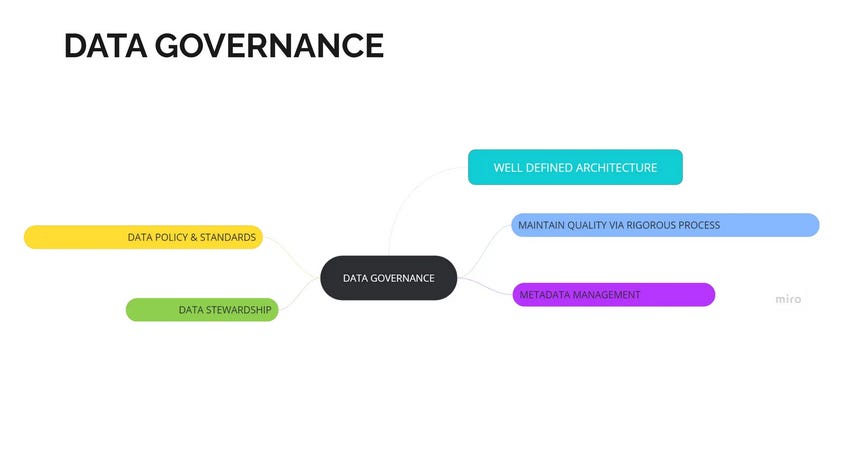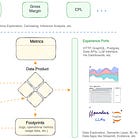Data Governance 3.0: Harnessing the Partnership Between Governance and AI Innovation
The modern governance framework for changing the narrative around Ethical AI, Innovation, and the alleged two-way friction.
This piece is a community contribution from Amy Raygada, a seasoned BI executive known for aligning data and AI strategy with corporate goals to drive business growth. A sought-after expert with over 18 years of experience in BI, data governance, and AI strategy. We highly appreciate her contribution and readiness to share her knowledge with MD101.
We actively collaborate with data experts to bring the best resources to a 9000+ strong community of data practitioners. If you have something to say on Modern Data practices & innovations, feel free to reach out!
🫴🏻 Share your ideas and work: community@moderndata101.com
*Note: Opinions expressed in contributions are not our own and are only curated by us for broader access and discussion. All submissions are vetted for quality & relevance. We keep it information-first and do not support any promotions, paid or otherwise.
When most people hear "data governance," they often imagine bureaucratic processes and strict controls that stifle creativity. It brings to mind a world of endless compliance tasks, tedious approvals, and unnecessary red tape. But what if, instead of hindering your AI projects, governance could actually help accelerate them? Believe it or not, smart governance frameworks can become powerful allies in driving AI innovation.

In Data Governance 3.0, Governance and Innovation aren’t adversaries; they’re teammates.
Governance Isn’t a Roadblock, It’s a Safety Net
There’s a widespread misconception that governance slows down AI work. It’s easy to assume that while AI teams thrive on experimentation and speed, governance is all about control and restriction. The reality, however, is far different. Without governance, AI projects can collapse under the weight of unforeseen issues. Here’s why:
Bad Data = Bad AI Models
If your data is incomplete or messy, it leads to inaccurate AI models and unreliable results.
Unchecked Bias = Reputation Risks
Left unmonitored, AI systems can reinforce biases, leading to damaging consequences.
Ignoring Regulations = Big Fines
Regulatory compliance isn’t optional; failure to adhere can halt projects and result in hefty penalties.
A well-implemented governance framework ensures AI systems are built on a solid foundation. It provides guardrails that let your teams innovate confidently while avoiding expensive mistakes.
Governance as a Seat Belt, Not a Speed Bump
Imagine you’re driving a car. Governance isn’t the traffic jam but the seat belt that’s keeping you safe as you speed ahead. It offers the protection needed to take risks and innovate without derailing your progress.
Here’s how governance can support and enhance your AI initiatives:
Clear Data Ownership: Assign someone to oversee each dataset’s quality, privacy, and lifecycle. Having clear responsibilities keeps everything running smoothly.
Data Catalogs and Lineage: Enable AI teams to quickly find relevant data. Documenting data origins and transformations ensures reliability and minimizes errors.
Build Trust Through Transparency: When teams and stakeholders understand how AI models work, trust and adoption naturally follow.
Transparency is more than sharing datasets; it includes explaining how models make decisions, their limitations, and the safeguards in place to ensure fairness. Building this trust is critical for fostering collaboration and encouraging calculated risks that lead to breakthroughs.
Building a Governance Framework That Fuels Innovation
To make governance an enabler of innovation, you need to approach it strategically. Here are actionable tips to create a governance framework that supports AI growth:
Treat Data as a Product
Think of datasets as products - with defined owners, quality standards, and regular updates. This ensures that data is always ready for AI teams to use.
Quick Tip: Flexibility is key. As your AI projects evolve, so should your governance practices. Adjust rules to meet changing needs.
Continuous improvement is essential. Like a product lifecycle, governance isn’t a one-time activity. Regular updates ensure your AI teams have access to high-quality data tailored to their evolving requirements.

📝 Further Reference(s)
Integrate Governance Into AI Workflows
Don’t treat governance as an afterthought. Incorporate it into every stage of the AI development lifecycle, from data sourcing to model deployment.
Quick Tip: Automate repetitive tasks like data quality checks and compliance validations. Automation minimizes manual effort and reduces bottlenecks.
Embedding governance early prevents costly rework. For instance, identifying and addressing compliance gaps upfront saves time and ensures smoother project execution. Automation tools play a crucial role in making these processes efficient.
📝 Further Reference(s)
Foster Cross-Functional Collaboration
Governance isn’t a one-person job in the organisation. Data scientists, engineers, and governance officers must work together to design policies that balance risk management with innovation.
Quick Tip: Organize collaborative workshops to align governance goals with innovation objectives.
Breaking down silos ensures governance policies are both practical and aligned with real-world needs. When governance becomes a shared responsibility, it empowers teams to innovate without fear of crossing boundaries.
📝 Further Reference(s)
Prioritise Ethical AI
Governance isn’t just about rules; it’s about doing the right thing. Focus on creating ethical AI by addressing bias, fairness, and transparency.
Quick Tip: Establish an ethics committee to review AI projects and provide actionable guidelines.
Ethical concerns are gaining prominence as AI systems influence critical decisions in areas like healthcare, hiring, and finance. Proactively addressing these issues builds trust and mitigates reputational risks. An ethics committee ensures your AI initiatives align with your organization’s core values.
📝 Further Reference(s)
This piece breaks down the cost of non-compliance with fundamental ethical requirements, for example ones laid out by the EU AI Act.
Track the Impact of Governance
How can you tell if your governance framework is working? Measure outcomes like reduced time to market, improved model accuracy, and minimized compliance risks.
Quick Tip: Use dashboards to showcase governance results to stakeholders, demonstrating its value in tangible terms.
Quantifying governance benefits helps dispel the notion that it’s a barrier. Metrics that highlight faster project timelines or fewer regulatory challenges prove its role as an enabler of innovation.
📝 Further Reference(s)
More on how to kickstart, optimise, and maintain Governance cycles through Data Product Ecosystems ↗️
Changing the Narrative Around Governance
It’s time to redefine how we talk about data governance. Instead of viewing it as a burden, see it as an indispensable tool for AI innovation. Data Governance 3.0 will be all about:
Empowering Teams: Providing AI teams with the right data at the right time.
Mitigating Risks: Addressing data quality, bias, and compliance issues before they escalate.
Driving Innovation: Enabling faster, more efficient experimentation and scaling of AI projects.
When governance is integrated seamlessly into workflows and treated as a collaborative effort, it unlocks AI’s true potential. It’s not a hurdle—it’s the bridge that connects innovation to sustainability and responsibility.
Ultimately, Data Governance and AI Governance isn’t just about managing risks, it’s about creating opportunities. It equips your teams with the confidence to push boundaries and explore new frontiers, knowing they’re backed by a strong, supportive framework. With governance as your ally, your AI projects won’t just progress; they’ll thrive.
MD101 Support ☎️
If you have any queries about the piece, feel free to connect with the author(s). Or feel free to connect with the MD101 team directly at community@moderndata101.com 🧡
Author Connect 🖋️
Connect with me on LinkedIn 🙌🏻
From The MD101 Team 🧡
Bonus for Sticking With Us to the End!
🤫 Insider Info from an Analytics Manager
An Analytics Project Lead for Global Analytics Tech at Wayfair, Sitian recently transitioned into the role of Senior Product Manager at Zalando—in a way emphasizing the close-knit nature of common skills between analytics and product domains. Making her story even more relevant for the data product wave.
Key to Decentralisation, Identifying the Single Source of Truth, and more with Sitian Gao | S1:E4
We added a summarised version below for those who prefer the written word, made easy for you to skim and record top insights! 📝
🧡 The Data Product Playbook
Here’s your own copy of the Actionable Data Product Playbook. With 1500+ downloads so far and quality feedback, we are thrilled with the response to this 6-week guide we’ve built with industry experts and practitioners.
Stay tuned on moderndata101.com for more actionable resources from us!












